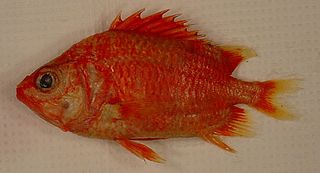
Mackerel is a common name applied to a number of different species of pelagic fish, mostly from the family Scombridae. They are found in both temperate and tropical seas, mostly living along the coast or offshore in the oceanic environment.

Herring are various species of forage fish, mostly belonging to the family of Clupeidae.

Fischer's guiara, is a spiny rat species found in Argentina, Brazil and Paraguay. It is one of only two species in the genus Euryzygomatomys. Its karyotype has 2n=46 and FN=88.
Neacomys spinosus, also known as the common neacomys, common bristly mouse, or bristly mouse, is a nocturnal rodent species from South America in the genus Neacomys. It is found in Bolivia, Brazil, Colombia, Ecuador and Peru, where it often lives in transition areas between lowland forest and open regions. Its diet consists of insects, seeds and fruit.

Triprion spinosus, also known as the spiny-headed tree frog, spiny-headed treefrog, spinyhead treefrog, coronated treefrog, and crowned hyla, is a species of frog in the family Hylidae. It has a spotty distribution in Panama, Costa Rica, Honduras, and southern Mexico. Previously in its own monotypic genus Anotheca Smith, 1939, it was transferred to the genus Triprion in 2018.
Temnothorax sentosus is a species of ant in the genus Temnothorax, that is native to Kazakhstan.

Pseudacanthicus spinosus, commonly known as leopard pleco, is a species of armored catfish native to Brazil and Ecuador where it occurs in the Amazon Basin. This species grows to a length of 26 centimetres (10 in) SL.

An anchovy is a small, common forage fish of the family Engraulidae. Most species are found in marine waters, but several will enter brackish water, and some in South America are restricted to fresh water.

The spiny red gurnard is a species of marine ray-finned fish belonging to the family Triglidae, the gurnards and sea robins. This species is found in the northwestern Pacific Ocean where they occur at depths of from 25 to 615 metres. This species grows to a length of 40 centimetres (16 in) TL. This species is of commercial importance as a food fish.

Chaunacops is a genus of marine ray-finned fishes belonging to the family Chaunacidae, the sea toads. This genus of deep-sea anglerfishes contains 4 species and these are found in the Indo-West Pacific. southeastern Pacific and Western Atlantic oceans. Little is known about the life history and biology of these fishes.

The spinycheek soldierfish is a species of soldierfish found in the Atlantic Ocean at depths of 45 to 275 metres. This species grows to a length of 20 centimetres (7.9 in) TL. It is the only known member of genus Corniger.

Eumicrotremus is a genus of lumpfishes native to the northern oceans. The name for this genus comes from the Greek roots eu meaning "good", mikros meaning "small" or "little", and trema meaning "hole".
Choeroichthys latispinosus, also known as the Muiron Island pipefish or Muiron pipefish, is a species of pipefish native to the western coast of Western Australia, named for its recorded sighting on South Murion Island. It is thought to inhabit the area from Port Denison to Brecknock Island in the eastern Kimberley region.
The thinlip splitfin is a species of ray-finned fish in the family Synagropidae. It lives around Africa's Atlantic coast at a depth of 50–500 m and can grow up to 16.5 cm long.
Dasyscopelus spinosus, the spiny lanternfish, is a species of lanternfish. It occurs in the Atlantic, Indian, and Pacific Oceans. It can grow to 9 cm (3.5 in) standard length.

Paracombrops is a genus of marine ray-finned fishes from the family Synagropidae. The fish in this genus are found in the Indo-Pacific.

Eumicrotremus spinosus, commonly known as the Atlantic spiny lumpsucker, is a species of lumpfish native to the Arctic and North Atlantic.
Cottunculus spinosus is a species of fish in the blobfish family Psychrolutidae. It is found in the south-eastern Atlantic Ocean off South Africa at depths of 1,460 to 2,180 m.













